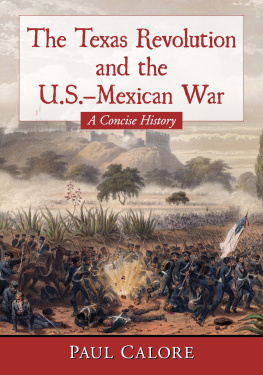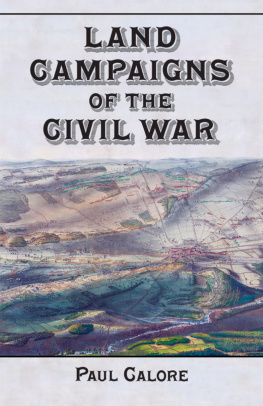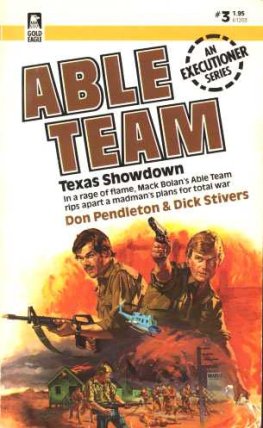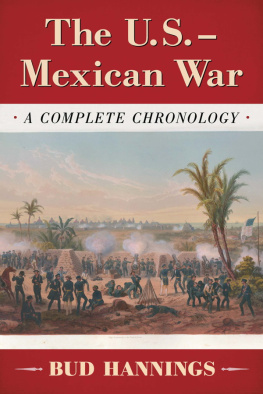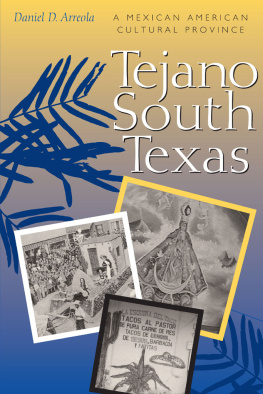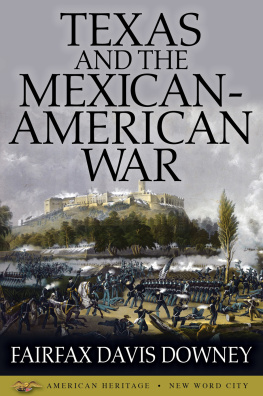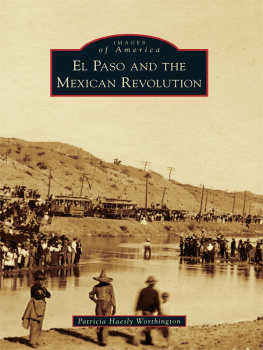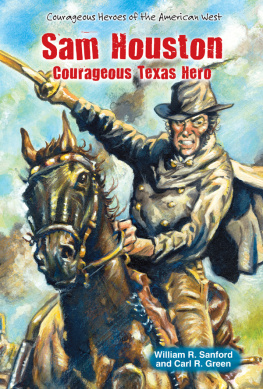
Also by Paul Calore and from McFarland
Land Campaigns of the Civil War (2000; paperback 2012)
The Causes of the Civil War: The Political, Cultural, Economic and Territorial Disputes between North and South (2008)
Naval Campaigns of the Civil War (2002)
The Texas Revolution and the U.S.Mexican War
A Concise History
PAUL CALORE

McFarland & Company, Inc., Publishers
Jefferson, North Carolina
Maps are by the author
LIBRARY OF CONGRESS CATALOGUING DATA ARE AVAILABLE
BRITISH LIBRARY CATALOGUING DATA ARE AVAILABLE
e-ISBN: 978-1-4766-1485-4
2014 Paul Calore. All rights reserved
No part of this book may be reproduced or transmitted in any form or by any means, electronic or mechanical, including photocopying or recording, or by any information storage and retrieval system, without permission in writing from the publisher.
On the cover: Storming of ChapultepecQuitmans attack (September 13, 1847) in the Mexican-American War; hand-colored lithograph; original size of painted area: 16" 10"; originally published in George Wilkins Kendal and Carl Nebel: The War Between the United States and Mexico, Illustrated (New York: D. Appleton and Company, 1851)
McFarland & Company, Inc., Publishers
Box 611, Jefferson, North Carolina 28640
www.mcfarlandpub.com

Mexico and Texas
Preface
As all enthusiasts of U.S. history know, the antebellum years of 1800 to 1860 were an incredibly fascinating period in the nations past. The country experienced such historical events as the dreadful curse of slavery, the innovations in railroad travel, the War of 1812, the Missouri Compromise, the rise and fall of abolitionism, the Underground Railroad, the rise of Manifest Destiny, the introduction of protectionism, the opening of the West, the Indian Removal Act, the growth of the Industrial Revolution, and the election of Abraham Lincoln, just to mention a few.
To the chagrin of some people, however, the commemoration of the American Civil War over the years since, although warranted, has to a large degree overshadowed two other significant events that took place during the antebellum years. Specifically, they were the fight for Texas independence, a conflict that not only awakened the spirit of the American people but also triggered the U.S.s first battlefield confrontation in a foreign country, and the second significant event: the U.S. war with Mexico.
These two chapters in American history were uniquely instrumental not only for expanding the United States geographically but also for establishing a new and exciting foundation for the development of its social, political, and cultural diversification.
This book recalls the political growing pains of two countries from 1835 to 1848, the sacrifices they made, the suffering they endured, and the selflessness of the human spirit, all for causes both sides believed were just.
Since obtaining her independence from Spain, Mexico had been a country tottering on the brink of political and economic collapse. Political instability in early independent Mexico resulted in an uncertain economic policy, no public programs for development, and, most important, violence and general disorder. Politicians gained and lost power frequently in a game of musical chairs. As a result, many economic policies changed drastically from one year to another or were quickly reversed, and those involving public programs were never enforced. The only solution by the various political factions was to overthrow the government they chose not to agree with. But to compound the difficulties, urban riots, demonstrations, assaults, and rural rebellions usually accompanied the frequent changes of governments.
Along with the political and economic turmoil bred from a series of corrupt, contradictory, and opportunistic leaders, Mexicos difficulties were compounded by the inherent problems of a country with too little to offer its citizens and too large an area for effective governance.
It was in this chaotic climate that Americas fascinating saga with Mexico began.
As the Mexican government struggled to resolve her financial problems, an attempt to strengthen the countrys economy was made with the introduction of empresarios, or agents responsible for settling colonists on free grants of barren land, in hopes of improving the economy of that region by their efforts at farming and ranching. The settlers, mostly southern Americans, came by the thousands to establish homesteads in Mexico on land that one day would be called Texas.
The early chapters of this book recount an intriguing story of the birth and growth of the empresario system in Mexico, the resourcefulness of the settlers, their achievements, and their struggles against a corrupt Mexican government obsessed with their removal from Mexican society. Once welcomed as fellow countrymen, after a time the colonists were considered to be enemies of the state and treated with merciless reprisals. As they struck back for a political cause they believed in, hundreds of raw, untrained, and determined frontiersmen gathered together in a volunteer army to challenge the might of the Mexican army in the so-called Texas Revolution. These efforts are highlighted herein.
Several later chapters recount the success of the Texans in gaining their independence and sovereignty as the newly formed Republic of Texas, a declaration fiercely resented by the Mexican government. And ten years later, the U.S. war with Mexico was triggered as a consequence of Texas annexation as the twenty-first American state and further instigated by military clashes at the Rio Grande border. Whether the war was politically motivated by the United States to carry out the principles of Manifest Destiny or by the Mexican government to take back Texas, the land stolen by the United States is still hotly debated to this day.
The U.S. war with Mexico, fought for just 21 months, is documented in the last three chapters, beginning with the western campaigns and continuing through the battles that led to the ultimate drive into Mexico City itself.
My hope is that readers of this work will learn two very important points: to appreciate the many hardships and sacrifices made by Texans who sacrificed their lives for the political freedom they believed in and for the right of self-determination, and to understand that the struggle to win the war with Mexico not only added over a half-million square miles to the United States, land destined to unleash a vast wave of western expansion, but also introduced a wide degree of diversification to the country, a cultural experience that ultimately benefited everyone.
1

Austin Colony to the Convention of 1833
For Moses Austin, once a wealthy industrialist and the founder of the U.S. lead-mining industry, times were getting much tougher. His story begins in 1783 when as a 22-year-old he became a partner with his brother in a dry-goods store in Philadelphia. Brought up as a Connecticut Yankee, Austin was so encouraged by the success they were having with the business that he decided to expand, to increase his participation in the entrepreneurial world on his own, and, more important, with plans for raising a family, to earn a much better income. Accordingly, he pulled up stakes and moved to Richmond, Virginia, where he opened a second business.
Next page
